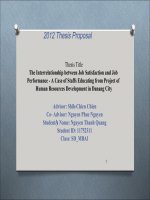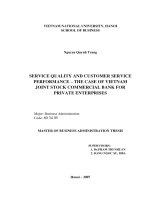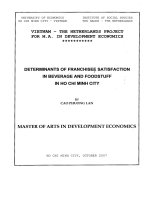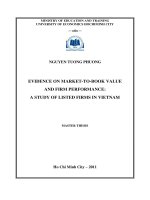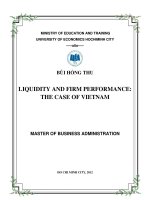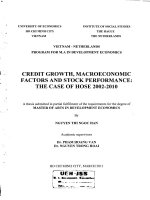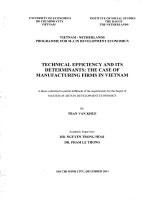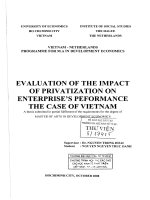Liquidity and firm performance the case of vietnam
Bạn đang xem bản rút gọn của tài liệu. Xem và tải ngay bản đầy đủ của tài liệu tại đây (1.04 MB, 62 trang )
MINISTRY OF EDUCATION AND TRAINING
UNIVERSITY OF ECONOMICS HOCHIMINH CITY
-----o0o-----
EÂ1
BÙI HỒNG THU
LIQUIDITY AND FIRM PERFORMANCE:
THE CASE OF VIETNAM
MASTER OF BUSINESS ADMINISTRATION
HO CHI MINH CITY, 2012
1
MINISTRY OF EDUCATION AND TRAINING
UNIVERSITY OF ECONOMICS HOCHIMINH CITY
-----o0o-----
EÂ1
BÙI HỒNG THU
LIQUIDITY AND FIRM PERFORMANCE :
THE CASE OF VIETNAM
MAJOR: BUSINESS ADMINISTRATION
MAJOR CODE: 60.34.05
MASTER THESIS
SUPERVISOR :
Dr. VÕ XUÂN VINH
HO CHI MINH CITY, 2012
2
i
________________________________________________________________________
ACKNOWLEDGEMENT
I owe my deepest gratitude to my supervisor, Dr. Vo Xuan Vinh, who with
his wide research experience, suggested this topic to me. Without his
continuous support, encouragement, and enthusiasm, this research would
hardly have been completed.
I am indebted to Dr. Tran Ha Minh Quan for his immeasurable amount of
support and guidance during MBA course and this thesis. I would like to
thank M.Sc. Nguyen Thanh Trung who willingly provided me with much
assistance and encouragement during MBA course.
I would like to thank Assistant Professor Nguyen Dinh Tho, Dr. Tran Ha
Minh Quan, Dr. Pham Quoc Hung, Dr. Nguyen Thi Mai Trang, Dr. Nguyen
Thi Nguyet Que for their valuable time as members of examination
committee. Their comments and advices are precious instruction for me to
complete this thesis.
I also express my warmest gratitude to my professors at Faculty of Business
Administration and Postgraduate Faculty, University of Economics
Hochiminh City for their teaching and guidance during my MBA course
I wish to thank warmly my classmates who show their teamwork spirit and
willingness to help each other to complete our theses.
Finally, this thesis is dedicated to my beloved wife who understands,
encourages, and is patient especially in the difficult period of taking care of
our newborn baby during my working.
ii
________________________________________________________________________
ABSTRACT
This thesis aims to investigate the relation between liquidity and firm
performance in Vietnam stock market. The debate on this topic is still open
when many papers point out that there is a positive correlation and many
researches show the opposite. The number of researches that support for
result of positive correlation is likely to be dominant. This paper shows the
negative correlation between liquidity and firm performance in Vietnam
stock market; however, the result is not consistent over time. The paper also
finds that liquidity has a negative correlation with financial leverage and this
implies that highly liquid firm tends to seek capital from the banks or bond
issues. Besides, there is a negative correlation between liquidity and
operating income on assets indicating that illiquid firm tends to focus more
on corporate monitoring and has more profitability. When examining the
correlation further on each industry separately, we find that this correlation is
only on five industries.
Keywords: Liquidity, firm performance, operating income to price, financial
leverage, operating income on assets, Vietnam.
iii
________________________________________________________________________
CONTENTS
ACKNOWLEDGEMENT ....................................................................................................i
ABSTRACT ........................................................................................................................ ii
LIST OF TABLES ............................................................................................................... v
ABBREVIATIONS ............................................................................................................vi
CHAPTER 1: INTRODUCTION ........................................................................................ 1
1.1 BACKGROUND ....................................................................................................... 1
1.2 RESEARCH PROBLEM ........................................................................................... 3
1.3 RESEARCH OBJECTIVE ........................................................................................ 3
1.4 RESEARCH METHODOLOGY AND SCOPE ....................................................... 3
1.4 STRUCTURE OF RESEARCH ................................................................................ 4
CHAPTER 2: LITERATURE REVIEW ............................................................................. 5
2.1 INTRODUCTION ..................................................................................................... 5
2.2 LIQUIDITY ............................................................................................................... 5
2.2.1 Bid-ask spread ..................................................................................................... 5
2.2.2 Turnover ratio ..................................................................................................... 8
2.2.3 Trading volume ................................................................................................... 8
2.2.4 Daily zero return ................................................................................................. 9
2.2.5 Amihud illiquidity ratio .................................................................................... 10
2.3 FIRM PERFORMANCE ......................................................................................... 10
2.4 LIQUIDITY AND FIRM PERFORMANCE .......................................................... 13
CHAPTER 3: RESEARCH MODEL ................................................................................ 18
3.1 INTRODUCTION ................................................................................................... 18
3.1 VARIABLE CONSTRUCTION.............................................................................. 18
3.1.1 Liquidity measures ............................................................................................ 18
3.1.2 Firm performance .............................................................................................. 19
3.1.3 Control variables ............................................................................................... 20
iv
________________________________________________________________________
3.2 MODEL ................................................................................................................... 21
CHAPTER 4: DATA AND RESEARCH METHODS ..................................................... 24
4.1 INTRODUCTION ................................................................................................... 24
4.2 DATA ...................................................................................................................... 24
4.3 RESEARCH METHODS ........................................................................................ 25
CHAPTER 5: RESULTS AND DISCUSSION ................................................................. 26
5.1 INTRODUCTION ................................................................................................... 26
5.1 DESCRIPTIVE STATISTICS AND CORRELATIONS ........................................ 26
5.2 REGRESSION ANALYSIS RESULTS ................................................................. 29
5.2.1 Baseline Q specification ................................................................................... 29
5.2.2 Baseline specification – components of Q ........................................................ 32
5.2.3 Baseline Q specification by industry ................................................................ 35
CHAPTER 6: CONCLUSIONS ........................................................................................ 37
6.1 INTRODUCTION ................................................................................................... 37
6.2 CONCLUSIONS...................................................................................................... 37
REFERENCES .................................................................................................................. 40
APPENDIX A .................................................................................................................... 44
APPENDIX B .................................................................................................................... 45
APPENDIX C .................................................................................................................... 46
v
________________________________________________________________________
LIST OF TABLES
Table 4.1: Variable definition ......................................................................22
Table 6.1: Summary statistics ......................................................................26
Table 6.2: Correlation matrix ......................................................................27
Table 6.3: Ordinary least squares regressions for the model ......................29
Table 6.4: Ordinary least squares regressions for the components of Q .....32
Table 6.5: Ordinary least squares regressions for Q by Industry ................35
vi
________________________________________________________________________
ABBREVIATIONS
HOSE
Hochiminh Stock Exchange
OIP
Operating income to price
LEVERAGE
Financial leverage
OIOA
Operating income on total assets
LIQ_TR
Liquidity measured by turnover
AGE
Firm‟s age
BVTA
Book value of total assets
IDIORISK
Idiosyncratic risk
CUMRET
Cumulative return
OLS
Ordinary least squares
1
____________________________________________________________________
CHAPTER 1: INTRODUCTION
1.1 BACKGROUND
Liquidity is one of the important factors that investors consider when
they make decision on investment. As defined by Amihud and
Mendelson (2008), liquidity is the capacity of the assets that can be
traded quickly and at low cost. According to Fang et al. (2009), the stock
shares are the currency which commands both cash flows and control
rights, the tradability of this currency plays a central role in the
governance, valuation, and performance of firms. The relation between
liquidity and firm value is firstly documented by Amihud and Mendelson
(1986). After this study, this relation draws more attention from other
scholars. There are many theoretical researches on this relation; most of
them support the positive relation and few researches suggest negative
relation. In research indicating positive relation, liquidity supports the
large shareholders to invest in large stake to become more majorities in
voting contests; it leads to effective corporate governance (Maug, 1998),
attracts the entry of the informed investors, in turn, this makes the price
more informative and improve the decision of the firm managers,
especially the firm with the uncertainty of cash flow in existing and
future projects (Subrahmanyam and Titman, 2001; Khanna and Sonti,
2004). Moreover, liquidity makes investors trade at higher prices than
more illiquid stocks (Holmstrom and Tirole, 1993), causes investors
trade at a premium because liquid stocks are overvalued due to the
2
____________________________________________________________________
liquidity could be a sentiment indicator (Baker and Stein, 2004), reduces
managerial opportunism because investors invest on the fundamental
value of the stocks (Edmans, 2009). There are few research studies on
negative relation, which conclude that liquid stocks facilitate the exit of
shareholders, therefore, they do not want to monitor firm performance
and leads to worse firm performance (Coffee, 1991), investors do not
want to sell when the cost of monitoring is not covered and it causes the
illiquidity in stock and better firm performance (Bhide, 1993), the
speculators use liquidity as a mean to make profit in manipulating price
down (Goldstein and Guembel, 2008). Hence, there are many papers on
both positive and negative relation between liquidity and firm
performance; however, most of these papers are about the theoretical
models. One of the first empirical papers investigating this relation is
written by Fang et al. (2009) supporting the positive relation between
liquidity and firm performance in US stock market. They use relative
effective spreads as liquidity proxy and Tobin Q for measuring the firm
performance. The result is robust when they use alternative liquidity
proxies: Amihud (2002) mean-adjusted illiquidity measure; the Lesmond
et al. (1999) percentage of zero daily returns liquidity measure; and the
relative quoted spread. Their findings support the theory of stock-price
feedback effect and performance-sensitive managerial compensation
causality.
3
____________________________________________________________________
1.2 RESEARCH PROBLEM
Over the world, there are not much papers that mention the empirical
research on the relation between liquidity and firm performance after the
first research of Fang et al. (2009). This paper aims to fill the gap of
lacking the empirical investigation in Vietnam stock market, one of the
emerging stock markets in the world.
1.3 RESEARCH OBJECTIVE
The objective of this paper is to examine the relation between liquidity
and firm performance on Vietnam stock market with the sample of listed
firms in Hochiminh Stock Exchange during the period 2007-2010.
The above objective of this thesis leads to the research question:
RQ1: Does liquidity have effect on firm performance?
1.4 RESEARCH METHODOLOGY AND SCOPE
The subject of this research is all listed firm in Hochiminh in the period
from 2007 to 2010. The sample size is 573. This paper uses quantitative
research based on Fang et al. (2009) model to investigate the relation
between liquidity and firm performance. We use various data analysis
methods in conducting the research such as descriptive statistics,
correlation matrix, and OLS regression with Eviews 6 for Windows.
4
____________________________________________________________________
1.4 STRUCTURE OF RESEARCH
Chapter 2 reviews prior work of previous researches. Chapter 3 selects
the model for this paper. Chapter 4 describes data collection and analysis
methodology. Chapter 5 contains the result and discussion of empirical
tests while Chapter 6 concludes.
5
____________________________________________________________________
CHAPTER 2: LITERATURE REVIEW
2.1 INTRODUCTION
Chapter 2 is to review the theories of liquid, firm performance, and the
relation between liquidity and firm performance in previous research studies.
2.2 LIQUIDITY
According to Amihud and Mendelson (2008), liquidity is the capacity of
the assets that can be traded quickly and at low cost. In recent years,
investors and scholars pay more attention to liquidity, and the research
on its relation with stock return is firstly documented in 1986 by Amihud
and Mendelson (1986). After that, a large number of research studies
have focused on it and its relation with stock returns and firm values.
Among of them, Eleswarapu and Reinganum (1993), Brennan and
Subrahmanyam (1996), Datar et al.(1998), Chordia et al.(2001), and
Fang et al. (2009) are few well-known studies.
There are a lot of methods to measure liquidity; in this paper, some main
measurements are presented.
2.2.1 Bid-ask spread
Suggested by Amihud and Mendelson (1986), bid-ask spread is the
difference between lowest price that seller want to sell and the highest
6
____________________________________________________________________
price the investors want to purchase. The higher the spread is, more
transaction cost the investors must pay to complete the purchase, and this
stock is considered as illiquid stock.
Bid-ask spread can be measured by three formulas:
The quoted spread
The relative spread
The effective spread
The quoted spread is the simplest formula; it is the difference between
the lowest selling price and the highest buying price:
where
QSi,t is quoted spread of asset i at time t.
is ask quoted price of asset i at time t
is bid quoted price of asset i at time t
The shortcoming of quoted spread method is that it does not have the
comparative capacity. If the spread is the same for two firms with
different prices, the firm with lower price should be low liquid than
another.
The relative spread is comparative method in comparing with quoted
spread, its formula as bellowing:
7
____________________________________________________________________
where
RSi,t is relative spread of asset i at time t.
is ask quoted price of asset i at time t
is bid quoted price of asset i at time t
is the mid price of asset i at time t
The effective spread is the difference between the natural logarithm of
actual price and the natural logarithm of the midpoint of the spread. It is
calculated after the transaction happened. It measures the actual
execution cost of the traders:
where
ESi,t is effective spread of asset i at time t.
is actual execution price of asset i at time t.
is mid price of asset i at time t.
The absolute value measures for the variance of both buying and selling
prices.
8
____________________________________________________________________
2.2.2 Turnover ratio
The method measures how many times the stock changes its owners, and
the higher the ratio is, the more liquid the stock has. Datar et al.(1998)
suggest this method in their study, and it becomes more popular in later
studies. Turnover ratio is measured by the number of trading shares in
one period by the number of share outstanding.
where
TRi,t is turnover ratio of asset i over the period t.
is number of trading share of asset i over the period t
is number of share outstanding of asset i over the period t
This method has some advantages. Firstly, the daily transaction data to
calculate is available for any stock exchange market. Secondly, liquidity
across stocks can be compared easily.
2.2.3 Trading volume
Trading volume has been adopted by many studies (Brennan et al., 1998;
Chordia et al., 2001).
9
____________________________________________________________________
It simply is the dollar volume trading in the period. The stock with
higher trading volume has higher liquidity. However, it may be distorted
by high price stocks.
2.2.4 Daily zero return
This method is constructed based on the concept that the return should
be larger than the cost that the investors pay when purchasing the stock.
Therefore, if the stock has more days of daily zero returns in one period,
it is considered as illiquid. It is firstly introduced by Lesmond et
al.(1999) and is used by some of later researches such as
Bekaert et
al.(2006), Fang et al. (2009).
It is the proportion of number of days that zero return occurs by the
number of trading day.
where
is daily zero return index of asset i over the period t.
is number of zero return days of asset i over the period t
is number of trading days of asset i over the period t
10
____________________________________________________________________
2.2.5 Amihud illiquidity ratio
Amihud (2002) in his paper proposes one more ratio to measure the
illiquidity of the stock. This ratio is defined as the average ratio of the
daily absolute return to the (dollar) trading volume on that day.
where
is the illiquidity ratio for stock i at year y.
is number of trading days of stock i in year y
is the return of stock i in day d, year y
is the dollar trading volume of stock i in day d, year
y.
The ratio can be interpreted as the average of the stock return on the
trading volume on daily basic.
2.3 FIRM PERFORMANCE
Measuring firm performance is one of the most widespread dependent
variable used by scholars in the economics field. However, it is also one
of vaguest variables in researches. It leads to the fact that the definition
and the measurement of firm performance vary widely (Murphy et al.,
1996).
11
____________________________________________________________________
Much of the research on performance measurement has come from
organization theory and strategic management (Murphy et al., 1996).
From organization theory, three fundamental theoretical approaches have
been evolved.
The first approach is goal-based approach. This approach suggests that
the firm evaluates its performance based on the goals it sets for itself
(Etzioni, 1964). However, this approach is not comparative between
different kinds of firm because each firm has its different goals (Murphy
et al., 1996). The second approach which is system approach has
compensated for the weaknesses of the goal-based approach(Steers,
1975). However, both goal-based and system approaches do not match
with the different expectations on firm performance of the stakeholders.
For this reason, the multiple constituency approach is evolved to satisfy
the different interest of stakeholders (Connolly et al., 1980; Murphy et
al., 1996)
From these three approaches of organization theory, Venkatraman and
Ramanujam (1986) classify the measurement of business performance
into
3
levels:
financial
performance,
operational
performance,
organizational effectiveness.
According
to
Venkatraman
and
Ramanujam
(1986),
financial
performance measurement is “to use of simple outcome-based financial
indicators that are assumed to reflect the fulfillment of the economic
goals of the firm”. This construct examines such financial indicators
such as sales growth, profitability (reflected by ratios such as return on
12
____________________________________________________________________
sales, return on investment, return on assets, and return on equity),
earning per share and so forth. These indicators have been used in some
researches (Demsetz and Lehn, 1985; Mehran, 1995). Since these
financial indicators only base on the accounting basic, the indicators
based on market price are more appropriate such as P/E, Market-to-book
ratio, etc. Many studies represent for this trend (Kudla, 1980;
Montgomery et al., 1984). Moreover, the approach that combines both
accounting and price-based indicators are widely used is Tobin‟s Q
value, which is invented by Tobin (1969). It is measured by the market
value of the firm assets divided by book value of its assets. Many
contemporary researches have been used this Q value (Kaplan and
Zingales, 1997; Shin and Stulz, 2000; Gompers et al., 2003; Fang et al.,
2009).
Operational performance measurement includes nonfinancial indicators.
In this construct, measures would logically be market-share, new product
introduction, product quality, marketing effectiveness, manufacturing
value-added ratio, and other measures of technological efficiency within
the domain of business performance (Venkatraman and Ramanujam,
1986).
According to Venkatraman and Ramanujam (1986), organizational
effectiveness measurement is used “when and conflicting nature of
organizational goals and the influence of multiple constituencies or
„stakeholders‟ are superimposed”. This construct uses comprehensive
factors to evaluate the firm performance such as importance of mission,
13
____________________________________________________________________
supportive policies toward the work force, appropriateness of
organization design, working conditions, pay and benefits, positive
supervisory practices, workforce loyalty and pride, organizational
efficacy, customer oriented behavior (Parhizgari and Gilbert, 2004).
Many of the models supported this construct (Steers, 1975; Zammuto,
1984; Hitt, 1988), but there is little consensus among these model.
Moreover, Steer (1975) indicates that this construct faces with eight
major problems: construct validity, criterion stability, time perspective,
multiple criteria, precision of measurement, generalizability, theoretical
relevance, level of analysis.
In summary, the measurement for firm performance now vary base on
the objectives and the situation at which the studies are conducted. In
reality, it is difficult to obtain of accurate and complete data for the
operational performance and organizational effectiveness measurement.
Therefore, scholars tend to use financial measurement as the major
method to evaluate the firm performance, especially the combination of
accounting and market base indicator, Tobin‟s Q ratio.
2.4 LIQUIDITY AND FIRM PERFORMANCE
In recent years, liquidity is a famous topic for many researches.
However, the first research about this subject is just begun in 1986 by
Amihud and Mendelson. They study about the asset pricing and the bidask spread and find that asset return increase with the spread. After their
14
____________________________________________________________________
study, many researchers continue their work. Using the same proxy for
liquidity (bid-ask spread) during the period 1961-1990, Eleswarapu and
Reinganum (1993) discover that the proposed relationship between bidask spread and stock return is predominantly confined to the month
January. However, Lee (1993 ), Brenna and Subrahmanyam (1996)
question about bid-ask spread proxy when they suggest that the quote
bid-ask spread is a noisy measure of illiquidity because many large
trades occur outside the spread and many small trades inside this spread.
That leads to alternative liquidity proxies such as trading volume
(Brennan et al., 1998), zero daily return (Lesmond et al., 1999), turnover
ratio (Datar et al., 1998; Chan and Faff, 2003), standard deviations of the
turnover ratio and of trading volume, and the coefficients of variation of
the turnover ratio and of trading volume (Chordia et al., 2001), the Pastor
and Stambaugh (2003) liquidity measure, the Amihud (2002) illiquidity
ratio, and the Liu (2006) liquidity ratio. Almost all of research studies
support the positive relation between liquidity and stock return.
As we mentions above, many researchers focus on liquidity as a risk
factor in pricing the stock, not in measuring the firm performance.
Therefore, there are a few research studies that mention about the
relation between liquidity and firm performance. Nevertheless, there are
two directions of effect of liquidity on firm performance, both positive
and negative sides. In which, the positive effect has supported by many
studies, while only few research has considered on the negative effect.
15
____________________________________________________________________
The positive effect of liquidity on firm performance is first mentioned by
Maug (1998). He proposes two effect of liquidity on firm control.
Firstly, liquidity facilitates the corporate control because it allows the
investor become the large shares holder to correct managerial failure.
Secondly, high liquidity makes the large shares holder to dispose her
stock rather than get involved to the corporate control. In this proposal,
he investigates the relation between liquidity and firm control. In the
theoretical framework, he concludes more liquid stock results in more
monitoring because monitoring cost is recovered through informed
trading, and in turn, improves the profitability of the firm.
Subrahmannyam and Titman (2001) study the feedback from stock price
to cash flows, an aspect of firm performance. They point out that the
increase of volume of liquidity attracts the entry of the informed
investors, in turn, it makes the price more informative and leads to the
improvement of the decision of the firm managers, especially the firm
with the uncertainty of cash flow in existing and future projects.
Khanna and Sonti (2004) investigate the feedback from stock price to
firm value. They argue that large traders consider not only the current
changes on stock price but also its further changes; therefore, they
monitor more about the performance of the firm managers. They also
conclude that stock herding by institution or funds, which creates high
liquidity and volatility, relaxes firm budget constraint, facilitates firms to
acquire the larger targets, and improves managers‟ investment decision.
16
____________________________________________________________________
Edmans (2009) examines the relationship between block holders trading
and managerial myopia in the circumstance of the U.S. market where the
dominant shareholding structure is one of small block holders. In his
research, he finds that small block holders also enhance firm value even
they lack the control rights. Since they trade on the fundamental value
rather than current earnings, the managers are encouraged to undertake
long-term investment instead of short-term interest.
Continuing the above studies, Fang et al. (2009) examine the effect of
liquidity on firm value measured by Tobin‟s Q ratio. They divide the
effect of liquidity on firm performance into two kinds of mechanisms,
agency-based effect and feedback effect. They also include the industry
and firm effect, a control for idiosyncratic risk, a control for endogenous
liquidity, and the use of alternative measures of liquidity for their
research. In the sample of 3174 firms from Center for Research in
Security Prices (CRSP) in the years 1990, 1993, 1995, 1998, 2000, 2002,
and 2004, they find that liquidity positively affects firm performance and
operating profitability. The we also point out that liquidity effects firm
performance through stock price feedback effect and manager pay-forperformance sensitivity.
However, in the positive effect, besides the agency-based effect and
feedback effect, some studies suggest that the causality of liquidity in
firm value by changing the discount rate. Holmstrom and Tirole (1993)
argue that the illiquid stock should be traded at a discount, this leads to
high price-based value when the stock is more liquid. Furthermore,
17
____________________________________________________________________
Baker and Stein (2004) suggest that high liquid stocks are overvalued,
and then they should be traded at a premium.
In contrast to the positive effect, there are a few research studies that
mention about the negative effect of liquidity on firm performance. In
the agency-based causality theory, Coffee (1991) suggests that the
institutions do not want to undertake the costly monitoring when they
have the liquid stock that facilitates their exits. Moreover, Bhide (1993)
argues that active shareholders reduce the costs of agency problem by
monitoring also reduce liquidity of stock because they do not want to sell
it when the cost of monitoring is not recovered. In contrast, illiquid stock
encourages the internal monitoring by preventing the exits of unhappy
shareholders. For the negative feedback effect, Goldstein and Guembel
(2008) point out that the speculators may utilize liquidity of the stock by
manipulating the price down that in turn leads the firm to cancel the
project investment, and it results in the decrease of the firm value.
The above papers suggest the following hypotheses:
H1: Liquidity has positive effect on firm performance.
